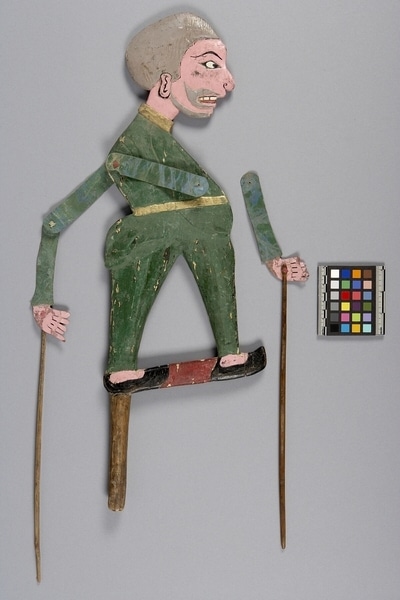Shadow Puppet Item Number: Ib324 from the MOA: University of British Columbia

Description
A two-dimensional humanoid figure puppet with a one-piece wood body carved in low relief. Unpainted wood handle extends below the foot on the left. Articulate leather arms attached at the shoulder with knotted string and are jointed at the shoulders and the elbows. Wood sticks are attached to the palms to manipulate the arms. Profile body and face are looking to the right. The pink face has a grey beard and moustache. Grey hair. The eyes are large and open. The upper teeth are visible. Wearing a green tunic and trousers with a band of gold paint at the neck and the waist. The pink feet are wearing black shoes with red ground in between.
History Of Use
Javanese puppetry as an art form probably developed by the 11th century. The three-dimensional wooden wayang golek puppets of western Java, which are to be distinguished from the earlier and more sacred wayang kulit shadow play puppets or other forms, appeared during the 16th century. Originally the plays depicted Javanese mythology, but after the Indian conquest of Java the Hindu epics, Ramayana and Mahabharata, were incorporated into the cycles, which comprise about 200 plays. An individual or group hires a dalang (puppet-master) to celebrate important occasions. The performances often last all night and are generally presented in three acts, with vocal and instrumental accompaniment. The individual plays vary widely in detail but usually involve conflict between good and evil. They serve a moral and religious purpose, and more recently, one of political commentary. Each puppet's character is represented by its appearance and placement onstage; protagonists with strong elements of good are placed to the right, antagonists of violent or evil nature to the left. Wayang suluk, or information theatre, was created by Indonesian guerrillas during the war of independence against the Dutch in 1947. Puppets depicting modern figures - soldiers, politicians, peasants - carved and realistically painted. Used to spread revolutionary ideas in a traditional media. Rarely performed after the war.
Cultural Context
Theatrical performance.
Iconographic Meaning
Figure apparently of a soldier or other outsider from the war of independence in, as indicated by uniform and colouration. Note that symbolic features from wayang purwa have been retained: pink face and wide eyes show a forceful or violent character.
Item History
- Made in Java, Indonesia
- Owned by Tradewind Antiques before March 15, 1983
- Received from Museum of Anthropology Shop Volunteers (Funding source) and Tradewind Antiques (Seller) on March 15, 1983
What
Who
- Culture
- Javanese
- Previous Owner
- Tradewind Antiques
- Received from
- Museum of Anthropology Shop Volunteers (Funding source) and Tradewind Antiques (Seller)
Where
- Holding Institution
- MOA: University of British Columbia
- Made in
- Java, Indonesia
When
- Ownership Date
- before March 15, 1983
- Acquisition Date
- on March 15, 1983
Other
- Condition
- poor
- Accession Number
- 0886/0058